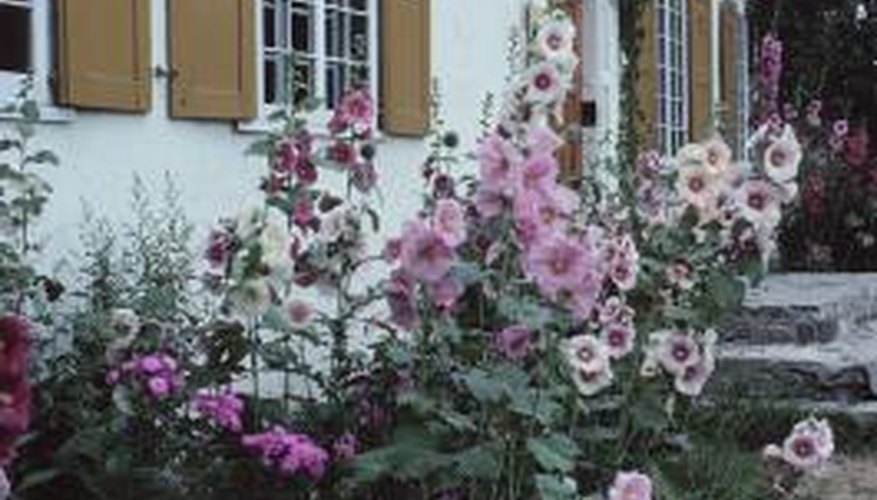New gardeners become frustrated when weeds infiltrate their gardens. If life has got in the way and you haven't given your garden the attention it deserves, you may find the weeds have blended into the plant life, making a positive identification difficult. Save yourself the heartbreak of accidentally culling your hollyhocks by learning to identify weeds with a similar appearance.
Mallow Weed
Mallow weed, Malva neglecta, or common mallow, is a distant cousin of the hollyhock. Mallow weeds resemble hollyhocks in leaf only. The blooms are the distinguishing feature; common mallow has white, pink or lavender flowers dissimilar in shape to hollyhock blooms. Leaves are alternate, hairy and have a circular or kidney shape with five to nine shallow, serrate, pointed lobes. The spread of common mallow is not like that of hollyhocks: hollyhocks grow erect; mallow weed grows prostrate. Mallow weed is common throughout the United States, according to the Virginia Tech Weed Identification Guide.
- Mallow weed, Malva neglecta, or common mallow, is a distant cousin of the hollyhock.
- The blooms are the distinguishing feature; common mallow has white, pink or lavender flowers dissimilar in shape to hollyhock blooms.
Creeping Charlie
Creeping Charlie, Glechoma hederacea, is a perennial weed with leaves resembling hollyhocks, but on a miniature scale. Creeping Charlie can be confused with hollyhocks' young, new growth. The leaves are circular to kidney-shaped, with scalloped edges and a thin coating of down. Creeping Charlie grows as a prostrate vine, spreading through gardens and yards. Flowers are blue and lavender and look like mutated, miniature pansies. Creeping Charlie is native throughout the United States. It prefers shady, moist areas, but readily adapts to other environments, notes the University of Minnesota Extension.
- Creeping Charlie, Glechoma hederacea, is a perennial weed with leaves resembling hollyhocks, but on a miniature scale.
Scarlet Globemallow
Scarlet globemallow, Sphaeralcea coccinea, also called slippery elm, is another distant cousin of the hollyhock plant. Scarlet globemallow grows erect, reaching about 2 to 3 feet tall. Its hairy stems and leaf shape are dissimilar to hollyhocks. Leaves of the scarlet globemallow are palmate with three to five deep lobes. Like the hollyhock, the leaves of the scarlet globemallow are hairy. Scarlet globemallow flowers look similar to hollyhock blossoms with short stalks and elongated clusters, in hues of orange, red and pink. The Utah State University Extension touts scarlet globemallow as drought resistant, mentioning that it may grow larger during times of neglect or stress. Scarlet globemallow favours dry grassland areas.
- Scarlet globemallow, Sphaeralcea coccinea, also called slippery elm, is another distant cousin of the hollyhock plant.
- Scarlet globemallow flowers look similar to hollyhock blossoms with short stalks and elongated clusters, in hues of orange, red and pink.
Wild Hollyhocks
Wild hollyhock, Sidalcea virgata, also called Cusick's checkermallow, is a native wild flower or weed that is endemic to, and endangered in, the Pacific Northwest, according to the Washington State University Extension. Wild hollyhocks resemble domestic hollyhocks in bloom and growth habit. Both plants grow upright and have a short-stalked, elongated flower. Wild hollyhocks produce pink blooms in mid-spring to early summer. They grow to about 4 feet tall and thrive in wet areas with full sun.
- Wild hollyhock, Sidalcea virgata, also called Cusick's checkermallow, is a native wild flower or weed that is endemic to, and endangered in, the Pacific Northwest, according to the Washington State University Extension.
- Wild hollyhocks resemble domestic hollyhocks in bloom and growth habit.
